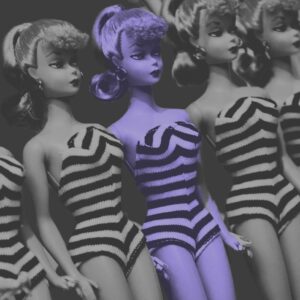
The Deep Connection of West Virginia's Indian Community
Neema Avashia on Childhood in the Kanawha Valley
It is 1982, and nine Indian women gather in a circle in a basement in Cross Lanes, West Virginia to celebrate the festival of Navratri. The basement floor is covered with bright blue carpet, the walls lined with brown, faux-wood paneling, and there is a red metal beam in the center of the room where a lighted brass pot called a garbo and idols of deities typically stand. Women, in sharp contrast to their damp surroundings, who are dressed in their heaviest silk saris and best jewelry: finery brought with them in suitcases that travelled 8,000 miles from India to New York, sometimes by way of Africa or London, and then another 500 from Queens to the Appalachian hills of West Virginia.
They are strangers in the strangest of lands, brought to the capital city of Charleston by engineer and doctor husbands who service the coal and chemical industries. The women spend the majority of their time in white, largely working-class spaces, trying to bridge the divide between their Indian accents and their neighbors’ Southern ones, their Hindu culture and the Bible Belt. Only on weekends and holidays do they find the opportunity to connect with others who share the same language, faith, and customs. A brief respite from a steady sensation of foreignness that pervades their day-to-day.
Each autumn, the women gather for nine nights, or as many as they can spare. Each night, a different color inspires their clothing. Each night, a different incarnation of the goddess Durga is the focus of their worship. Durga, queen among Hindu goddesses, warrior for good, vanquisher of evil. She is often depicted astride a tiger, holding a sword, a trident, a mace, and a dagger in her many hands. Durga literally means unassailable. She is the Mother goddess who will not be challenged or questioned in her battle to preserve the dharma of the righteous.
These worshippers of Durga begin each night the same way, singing the mataji na garba in voices that are pitched and clear. With their words, they praise the many forms and powers of the Mother goddess. They slowly clap and slide around the circle, their motions repetitive and rhythmic. They pick up speed. The two-clap step builds to three. Their bodies blur, faces lost in a whirl of spinning, shining colors. The smell of sweat, mixing with perfume and powder, fills the room. In the morning, tiny purple bruises will dot their arms, induced by the repeated banging of their glass bangles. The soles of their feet will bear the red flames of carpet burn. Their waists will host a near-permanent indentation from the tightness of their petticoats. But for these nine nights, there is no pain insufferable enough to make them leave the circle early.
The sharpest pang is the one asking me to go backwards in time, back to the tiny Indian community nestled in the Kanawha Valley, back to the basement in Cross Lanes.
This is the festival of Navratri. In Gujarati, Nav means nine, and rat means night. Nine women, nine nights, nine colors. Nine forms of the Mother goddess spinning in front of me.
*
More than 35 years later, I live in Boston, Massachusetts, one of the oldest cities in the U.S.; home to Harvard and MIT and several other distinguished universities. Despite its five million people, I have no Indian community to speak of. There are weekend Navratri garbas in the suburbs, massive gatherings of Indians I do not know, in the gymnasiums of middle schools I’ve never heard of. I feel no pull to go to these anonymous celebrations where ritual feels meaningless in the absence of relationships. Instead, the sharpest pang is the one asking me to go backwards in time, back to the tiny Indian community nestled in the Kanawha Valley, back to the basement in Cross Lanes, back to the garba where the faces in the circle are the faces of my many mothers, and their characters are the unassailable personifications of Navadurga.
Though I was just three at the time, when I envision the Cross Lanes garba, I see myself as I look now, and my mothers are all my age. I take the place of Shailaputri, worshipped on the first day of Navratri. Like her, I, too, am a daughter of the mountains. Born and raised in West Virginia, I straddle the culture of my parents and the culture of my Appalachian birthplace. Autumn elicits nostalgia not just for Navratri but also for the mountains of my home state, set aflame in oranges, yellows, and reds. I experience a double-loss each Fall, missing both the mountains of my childhood and the many mothers who played a role in raising me there. In Gujarati, the word for maternal aunt is masi—”mother-like.” So to my mother’s chosen sisters I cleaved. Because of the familiarity they provided in the most foreign of contexts, they became my masis. My mother-likes.
As the lone Indian girl in my classes at school, I was surrounded by white girls whose parents allowed them to dress in tight clothing, wear make-up, and put chemicals in their hair. Whether because of my awkward appearance, my brown skin, my yet-to-be-realized sexuality, or some combination of the three, dating was never an option for me. I knew that I could not be like the girls in my classes, but struggled to find a cohesive identity for myself.
Their words were cathartic, followed by actions that further confirmed a fact I should have known all along—that for my mothers, love dampened any prejudices that might have occurred to them otherwise.
So it came to be that my many mothers took the traditional place of aunts and cousins in teaching me how to be a good woman, and how to live a righteous life. In the absence of any other role models to help me understand what it meant to be an Indian woman, and what it meant to be in a relationship, their definitions are the ones I used to construct my own identity—sometimes by reflecting their image, and sometimes in direct opposition to it.
*
Dancing beside me in this ring of women is Indira auntie, the mother of my oldest childhood friend. She embodies Bhramacharini, the incarnation of Durga best known for her devout austerity. For the entirety of my childhood Indira auntie lived in a one-level, three-bedroom house with her husband and five children; on a single income earned at a low-paying job in the West Virginia state government.
I invaded her house and refrigerator on a regular basis, sleeping over for multiple nights at a time, and consuming every pickle in every jar, draining them of their neon brine afterwards. In retrospect, I can recognize the very real financial struggles that her family faced. The ramen noodle lunches that felt like a guilty pleasure to me when compared with my doctor-dad’s demands that we eat fiber and salad were a necessary staple in her feeding five growing children. Yet never once did she make me feel as though I was draining her wallet, or that there wasn’t room for me at her brown laminate dining table.
Indira auntie’s house was the first place where I remember having conscious questions about gender in Indian culture. Auntie had four daughters, and one son. Yet their car’s license plate carried their son’s name. So did the family business, even though her daughters were the ones earning honor roll, becoming valedictorians, and getting full scholarships to college. I never got the sense this was auntie’s choice. But what did it mean about an Indian woman’s ability to recognize and reward her daughters? To value and honor the lives they were creating, instead of simply valuing a son for his male-ness? As I watched Indira auntie’s daughters rack up their awards, I wondered: what level of accomplishment would a woman need to ascend to in order for her success to outweigh her gender?
On the other side in the nine-woman circle stands Asha auntie, exuding the peace and tranquility of Chandraghanta. A pale-skinned Punjabi, with angular features and the most lilting of all the auntie’s accents, Asha auntie showed her love for us through her cooking. I have never tasted a paneer dish in a restaurant, or in another home, that comes anywhere close to the perfect texture and seasoning of food I ate in her kitchen.
Even when I was young, I was cognizant of Asha auntie’s grace and femininity—her perfectly coiffed hair, manicured nails, and beautifully tailored suits. Being around her heightened my awareness of my own frizzy hair, dark skin, bitten down nails and baggy clothes. I did not want to be like her; I simply saw in her a kind of womanhood that I was certain I could never approximate.
What’s more, she navigated the painful economic divide between her and her wealthier friends with a kind of grace that blew me away as I got older and could see the strain it placed on their relationships. While her friends bought increasingly bigger houses and fancier cars, Asha auntie’s living conditions stayed the same. My mom used to say that you could show up at Asha auntie’s door at any time, on any day, and never feel anything but welcome. Unemployment, caring for aging parents, financial hardship—the weight of it all never showed on her face.
Asha auntie, who worked the hardest, also died the youngest, of a lung cancer whose source we never understood. It was my many mothers who washed her body, combed her hair, trimmed her nails, did her make-up, and wrapped her in a sari for the final time before her cremation.
Across the circle is the eldest of my mothers, and the elder in our community, Shobana auntie. She was one of the first Indians to come to the Kanawha Valley in the mid 60s, forging the path for the hundred or so families who would eventually come to live in our community. Her husband, Sharad uncle, was killed in a terrible accident when his car was sideswiped as he pulled onto Big Tyler Road. Their children were barely teenagers at the time.
After his death, Shobana auntie became our community’s first single mother, the living embodiment of Kushmanda, the deity who represents strength and courage in the face of adversity. She invited me to her house high on the hill of Mourning Dove for thalipit, a traditional Maharastrian dish, every time I came home from college. And no matter how badly her arthritic hands ached, or how hard her fingers fought against yielding to their clenched-fist state, she refused to let me help her pat the dough into shape, or fry it on the skillet.
“You sit and rest,” she would say. “You work so hard in school. The least I can do is feed you.”
In a culture where the quantity of ghee used is equated with the quantity of love felt, Shobana auntie’s thalipit always arrived at the table with innumerable pools of clarified butter glistening on its crispy surface.
Shobhana auntie’s neighbor, both in the circle and in our town of Cross Lanes, is Jyoti auntie. Her enthusiasm for garba, and the grace with which she moves around the garbo, is unmatched. The shortest of all the women, with a braid that runs half the length of her body, she makes up in energy what she lacks in height. She is Skanda Mata incarnate—pure and divine of nature. The most religiously devout of my mothers, Jyoti auntie is the person to ask when questions of ritual or faith arise. She is also a walking Gujarati dictionary, and the sunniest person I know.
When I took my white, Jewish/Irish/Italian female partner to West Virginia to meet my mothers, and sent a hesitant text to each one asking if they wanted to meet us, this was the rejoinder that she and her husband Praful uncle sent:
Neema, I am angry with you that you felt the need to call and ask if we are ok with your and Laura’s visit. We are your second home and family. So no matter what, we will always be there for you. Also don’t waste your money by staying in a hotel or some other place. We have plenty of rooms (may not be as clean) and save money for the gas (went up yesterday by 40 cents per gallon). See you soon.
Their words were cathartic, followed by actions that further confirmed a fact I should have known all along—that for my mothers, love dampened any prejudices that might have occurred to them otherwise.
Jyoti auntie embraced Laura, and called her beta (my child), as she did for all of the young people in our community. After meeting us in a restaurant for dinner, she insisted that we come to her house and sit in her living room, where she plied us with slices of mango pie and cups of chai. There was no judgement in her heart, only a kind of unconditional love and acceptance that I am blessed to have bestowed upon me.
The owner of the basement where this garba unfolded, Ranju auntie, makes her way around the circle beside Jyoti auntie. She is a living manifestation of Katyayani, who is described as having wild hair and 18 arms, and emitting a radiant light from her body which makes it impossible for darkness and evil to hide. Ranju auntie is tall, with untamed curly hair and a Cindy Crawford mole above her lip, and by far the most disciplinarian of my mothers.
I simultaneously feared Ranju auntie, and was awed by her. Her magical sitting room, with its zebra skin wall hangings, orange plush birdcage chair, and cinema organ, was so different from the staid furniture in my own house, and in those of my neighbors. Her kitchen almost always had a caged bird in it that would utter random Gujarati phrases when you walked in.
Once, my parents left me in her care when they went out of town. During our time together, she decided to take me to Sears for a photo shoot. Ranju auntie styled my long, curly hair in a fashion far different from my traditional braid. She dressed me in cute jeans, a fitted red Sesame Street turtleneck, and cowboy boots, and coaxed me into a pose where I am sitting with one leg crossed over the other, laughing almost flirtatiously.
It is the most “girly” photo in my album of pictures from childhood—somehow managing to be more feminine than all of my awkward prom pictures combined. She didn’t ask my parents for permission to take these photos beforehand, just gave them the prints afterwards. Proof, perhaps, that my tomboy self could be tamed if they took it upon themselves to do the taming, as she had.
Ranju auntie lost her pain-filled battle with oral cancer before I could ask her the questions I now have about her childhood in Tanzania, about being a working mom when so many of her peers were staying at home, about being unafraid to live her life in the boldest of reds, greens, and yellows even as those around her continually tried to tone her down.
Next to Ranju auntie is my mother’s best friend in this group, Shobha auntie. Her garba style is more stiff and mechanical than that of her neighbors in the circle. Garba is not Shobha auntie’s strong suit, in the way that it is for some of the other women, but she participates nonetheless. The mother of three sons, Shobha auntie has called my sister and me her daughters from the outset. We benefit from all of her motherly love, with none of the filial responsibility.
She fills yogurt containers with enough fried snacks to last me for weeks after a visit, insists that I eat a meal with her at her home high in the hills that ring the city of Charleston, and cooks my favorite foods, most especially her okra, which is crispy in a way I am never able to replicate. Shobha auntie was the first person my mom called when I came out to her, and she embraced Laura with the no-nonsense logic that she applies to all situations.
“If Neema is happy, and Laura makes her happy, that is what matters to me,” she told my mom. Whenever my mom has struggled with reconciling my identity with the beliefs of her traditional Indian family, it is Shobha auntie who has counseled her, firmly stating that those family members need to “figure it out and deal with it,” and that it isn’t my job, or my mom’s, to accommodate them.
Though she has always been consistent with me, Shobha auntie’s personality is much like that of Kaal Ratri, the goddess who is both honored and feared. She runs hot and cold in a way that can leave her friends feeling abandoned at times. I watched my mom’s friendship with Shobha auntie ebb and flow over the years, and learned from their interactions how to navigate the changing terrain of friendship, how to provide space without running away.
To Shobha auntie’s right in the circle, my sister Swati dances with abandon, her heavy sari no match for her love of dancing. Her eyes are bright and lined with kohl, her long black hair spills down her back. Born when my mother was just 21, and seven years older than me, Swati has always inhabited a strange space in our family—closer to a sister than daughter for my mom, and closer to a mother than sister for me.
Swati is the voice of calm and reason in this group, the goddess Maha Gauri, whose primary power is her ability to allay fears. When I decided to start telling my family about Laura—the only relationship I’ve ever shared with them—there was no doubt in my mind that Swati was the person to confide in first.
I called her one summer evening in 2010 from the parking lot of Roxbury Community College in Boston, where I was attending a teacher training. Words spilled out in a rush, some combination of, “I’m dating a woman,” “It’s serious,” and “Please don’t tell mom and dad yet.”
There was no hesitation in Swati’s voice when she finally got a chance to speak. “I’m so happy for you, Neema. I can’t wait to meet her.”
It was Swati who coached me through how to tell my mom about Laura. It is Swati who has held every debrief conversation with my mom when she hasn’t understood my choices: Why, for example, I won’t attend a wedding when Laura’s name isn’t written on the invitation. Or why I don’t want to visit India after hearing homophobic comments from family members on my last visit.
And it is Swati who now helps me navigate new terrain: that of trying to become a mother myself, in a way that none of my many mothers was able to model for me.
The last person in this tight circle of fabric and flesh is my own mother, her smiling face ringed by wisps of hair that have escaped from her tight braid. She is the one whose singing voice I hear most clearly, because it is the voice that never falters during garba. Her grace and femininity are traits I have come to appreciate over the years, even as I’ve come to accept that they have been passed on to my sister and niece, while skipping over me. Acceptance of this fact has not come as easily for her.
When I was small, my mom sang the same bedtime songs to me that her older brother had sung to her when she was growing up. One, in particular, stands out in my mind. It was a song about a single woman who doesn’t understand why she is still single. Each verse outlines all of the qualities that make her a desirable bride. Her father has a car, her grandfather has a horse and buggy, her uncle has a flower garden. She is fairer than her older sister, and skinnier than her younger sister. She goes to college, goes out to eat in restaurants, and goes to see movies. And yet, despite all of this, she remains single.
My mom took the song’s message at face-value: the role of a woman in India was to marry, bear children, and be an obedient wife and giving mother. She performed those gendered expectations to the best of her ability. I listened to the same song and thought, in the words of any typical 6-year old, “What kind of capitalist, sexist, shadist nonsense is this?” Our paths in life have been quite different as a result. She has been married to my father for almost 50 years while I have been in a same-sex relationship with my partner, Laura, for the last nine without any ceremony conferring it legal status.
In this group of women, my mother is the peacemaker and the relationship-builder. When she moved away from the Kanawha Valley after thirty years of living there, the ties among the rest of the women slowly unraveled. My mother is Siddhidatri, the giver of supernatural powers. She constantly seeks out learning opportunities and ways to share her experiences with those around her. More than any of her peers, she threw herself into the broader American community of Charleston, West Virginia. She did taxes for free at the local library for the working class white folks who needed help completing their paperwork. She volunteered as a docent in our tiny art museum. She became the leader of my Girl Scout troop and used the opportunity to educate my white peers about Indian culture and customs. She earned her MBA at night, then got her CPA, and worked 15-hour days during tax season, but never failed to have dinner on the table at night for her family. And she did all of this while negotiating the impossible demands and expectations of a traditional Indian man and entitled children.
I told my mom that I was dating Laura when we were sitting at her dinner table late one night in Kansas City, where she and my father had moved after leaving Cross Lanes. I was crying as I told her, uncertain as to what her response would be.
“The most important thing to me is that you are happy, Neema. I just don’t want your life to be any harder than it has to be, and I worry that this will make it harder.”
For a woman who was raised in a country where being gay was illegal until September of 2018, on the very day that I write this, and who spent the majority of her adulthood in the Bible Belt, this response was more than I could have asked for. But her subsequent response—her embrace of Laura, the mushy letters she sends her each birthday saying, “I’m so happy that Neema has you in her life,” have proved yet again that my mom’s capacity for growth, and for love, are boundless.
Though I can’t stand in circle with them this Navratri, it is their faces, their voices, their presence that I feel when the first sounds of the garba come through my speakers on my drive home from work.
I was not fair to my mom growing up, unable to recognize the impossible balancing act she accomplished every day as she advanced in her education and career, and still put a traditional Gujarati dinner, with its four separately-prepared components, on the table each night. I still cringe remembering the moment as a teenager when I yelled at my mom because a piece of clothing I needed hadn’t yet been ironed. As an adult, struggling to work, take care of my home, be present in my relationship, be a present and engaged aunt for my niece, I wish for my mom to bestow me with the supernatural powers she seems to possess.
*
Today is Dussehra—the 10th day of Navratri. After nine days of fasting, feasting, and dancing, Navratri in India ends with this tenth day off from work and school to celebrate the victory of Good over Evil. Effigies of demons get burnt in bonfires. People begin new jobs and new journeys.
This year in Boston the sky is grey and raining during Dussehra. Laura’s Irish-Italian father is here for a visit, and we will spend the day together carbo-loading: starting with breakfast at a diner, followed by a beer tasting where I politely endure bitter sips of brew, and ending with three courses of pasta for dinner. It is quite possibly the least Indian of Navratri experiences that my mothers could have wished for me. Still, I know they would be proud that I am doing what they taught me to do: be family in the way that people need you to be. And though I can’t stand in circle with them this Navratri, it is their faces, their voices, their presence that I feel when the first sounds of the garba come through my speakers on my drive home from work. It is them I seek to honor when I sing praises to Durga Mata.
__________________________________

From Sweeter Voices Still: An LGBTQ Anthology from Middle America, edited by Ryan Schuessler and Jr. Kevin Whiteneir. Used with the permission of Belt Publishing.
Neema Avashia
Neema Avashia is an 8th grade Civics teacher in the Boston Public Schools, where she has taught for the last 16 years. She grew up in Cross Lanes, WV, in the heart of the Chemical Valley.



















